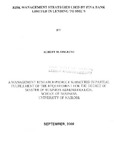| dc.description.abstract | Bank financing of small and medium-sized enterprises (SMEs) recently received renewed
interest as a result of the ongoing internationalization of financial markets for corporate
finance. Effective risk management, from the point of view of financial institutions, is the
key to the future success in banking and therefore these institutions should focus on
professional management of risk. The successful financial institutions are and will
increasingly be those that develop focused strategies, lower their overhead ratios,
ingeniously exploit their advantages and know how to calculate their risks. The most
important areas of concern to banks in credit risk management is to be integrative in
terms of risk a bank is taking in doing business by client, by channel, by product, by
business, by industry, by currency and by country.
The objective of this study was to investigate the risk management strategies used by
Fina Bank limited in lending to SMEs. A survey method with reference to Fina Bank of
Kenya was adopted. Primary data was collected for the purpose of this study using a self
administered interview guide. The variables focused on included Credit scoring models,
Credit Policy, Credit risk assessment and approval level, Credit risk management
methodologies, 6 C's Credit Appraisal and Default Rate measurement and evaluation
issues around risk management strategies at Fina Bank of Kenya .
The results of the study indicate that risk control is the most central aspect of risk
handling and can involve a variety of different strategies. One of these seeks to reduce the
magnitude of risk by controlling the terms on which the loan has been granted for
instance interest rate variability, another consists of demanding security and using the
12Cs in credit risk assessment.
Risk management strategies are not a substitute for poor management. This will only
succeed where best management practices are practiced. The study was however, limited
to Fina Bank due to time and cost constraints. Replication of this study through
comparative study using samples from other institutions is thus recommended. | en |

